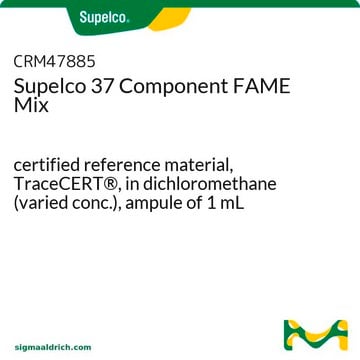The solution stability is reported as followed: A solution of the product can be stored in neutral buffer or below (pH 3-7) for no longer than two weeks at -20°C when divided into aliquots. This is recommended for keeping the solution stable. It would be better to prepare fresh solutions and use soon after.
A2056
Acétyl-coenzyme A trisodium salt
≥93% (HPLC), powder
Synonyme(s) :
Acetyl-S-CoA, Acétyl-CoA
About This Item
Produits recommandés
Niveau de qualité
Essai
≥93% (HPLC)
Forme
powder
Solubilité
H2O: 100 mg/mL
Température de stockage
−20°C
Chaîne SMILES
O[C@H]1[C@](O[C@@H]([C@H]1OP(O)(O)=O)COP(OP(OCC(C)(C)[C@@H](O)C(NCCC(NCCSC(C)=O)=O)=O)(O)=O)(O)=O)([H])N2C3=NC=NC(N)=C3N=C2.[3Na]
InChI
1S/C23H38N7O17P3S.Na/c1-12(31)51-7-6-25-14(32)4-5-26-21(35)18(34)23(2,3)9-44-50(41,42)47-49(39,40)43-8-13-17(46-48(36,37)38)16(33)22(45-13)30-11-29-15-19(24)27-10-28-20(15)30;/h10-11,13,16-18,22,33-34H,4-9H2,1-3H3,(H,25,32)(H,26,35)(H,39,40)(H,41,42)(H2,24,27,28)(H2,36,37,38);/q;+1/p-1/t13-,16-,17-,18?,22-;/m1./s1
Clé InChI
HNLIOWFIXSPFEC-WLYMNMRISA-M
Informations sur le gène
human ... CHAT(1103) , HAT1(8520) , KAT2A(2648) , KAT2B(8850) , KAT5(10524)
mouse ... HAT1(107435) , KAT2A(14534) , KAT2B(18519) , KAT5(81601)
rat ... HAT1(296501) , KAT2A(303539) , KAT2B(301164) , KAT5(192218)
Vous recherchez des produits similaires ? Visite Guide de comparaison des produits
Application
Actions biochimiques/physiologiques
Notes préparatoires
Autres remarques
Code de la classe de stockage
11 - Combustible Solids
Classe de danger pour l'eau (WGK)
WGK 3
Point d'éclair (°F)
Not applicable
Point d'éclair (°C)
Not applicable
Équipement de protection individuelle
Eyeshields, Faceshields, Gloves, type N95 (US)
Faites votre choix parmi les versions les plus récentes :
Certificats d'analyse (COA)
Vous ne trouvez pas la bonne version ?
Si vous avez besoin d'une version particulière, vous pouvez rechercher un certificat spécifique par le numéro de lot.
Déjà en possession de ce produit ?
Retrouvez la documentation relative aux produits que vous avez récemment achetés dans la Bibliothèque de documents.
Les clients ont également consulté
Articles
Sigma article discusses tumor cell metabolic pathways, focusing on aerobic glycolysis and mitochondrial activity.
Sigma article discusses tumor cell metabolic pathways, focusing on aerobic glycolysis and mitochondrial activity.
Sigma article discusses tumor cell metabolic pathways, focusing on aerobic glycolysis and mitochondrial activity.
Sigma article discusses tumor cell metabolic pathways, focusing on aerobic glycolysis and mitochondrial activity.
Protocoles
To measure chloramphenicol acetyltransferase activity, this procedure uses DTNB and coenzyme A. The reaction of DTNB with the –SH group on CoA results in a colorimetric increase at 412 nm.
To measure chloramphenicol acetyltransferase activity, this procedure uses DTNB and coenzyme A. The reaction of DTNB with the –SH group on CoA results in a colorimetric increase at 412 nm.
To measure chloramphenicol acetyltransferase activity, this procedure uses DTNB and coenzyme A. The reaction of DTNB with the –SH group on CoA results in a colorimetric increase at 412 nm.
To measure chloramphenicol acetyltransferase activity, this procedure uses DTNB and coenzyme A. The reaction of DTNB with the –SH group on CoA results in a colorimetric increase at 412 nm.
-
What is the solution stability for the A2056, Acetyl Coenzyme A?
1 answer-
Helpful?
-
-
What is the formula weight for the Product No. A2056, Acetyl Coenzyme A?
1 answer-
The formula weight for the Product No. A2056, Acetyl Coenzyme A, as reported on the website is for the free base with a weight of 809.57 daltons.
Helpful?
-
-
For Product No. A2056, Acetyl Coeznyme A, why is the formula weight listed on the website and the formula weight listed on the label different?
1 answer-
The difference in the formula weights reported for Product No. A2056, Acetyl Coenzyme A, on the website versus the label is due to the sodium and water content of the product which may vary from lot to lot. The formula weight of the free base is reported on the website, however on the label, variations in sodium and water content will reflect differences in formula weights reported on the label for a specific lot of product.
Helpful?
-
-
What is the Department of Transportation shipping information for this product?
1 answer-
Transportation information can be found in Section 14 of the product's (M)SDS.To access the shipping information for this material, use the link on the product detail page for the product.
Helpful?
-
Active Filters
Notre équipe de scientifiques dispose d'une expérience dans tous les secteurs de la recherche, notamment en sciences de la vie, science des matériaux, synthèse chimique, chromatographie, analyse et dans de nombreux autres domaines..
Contacter notre Service technique













